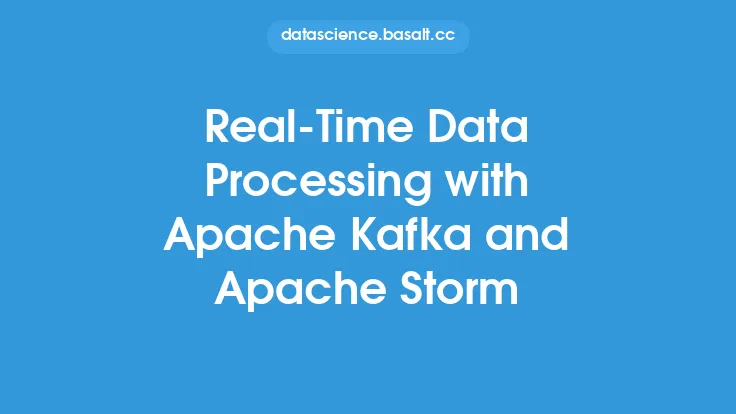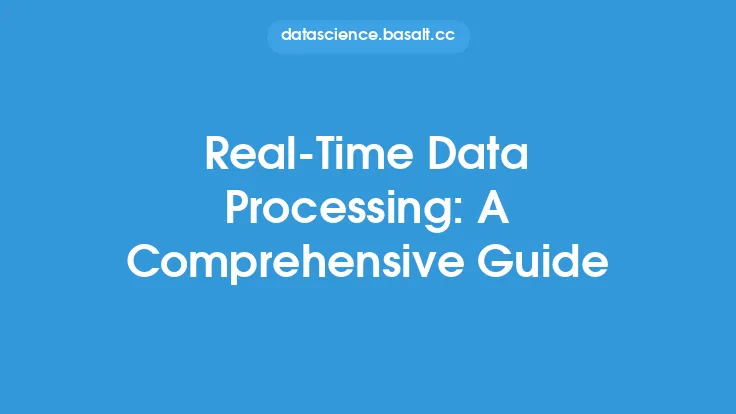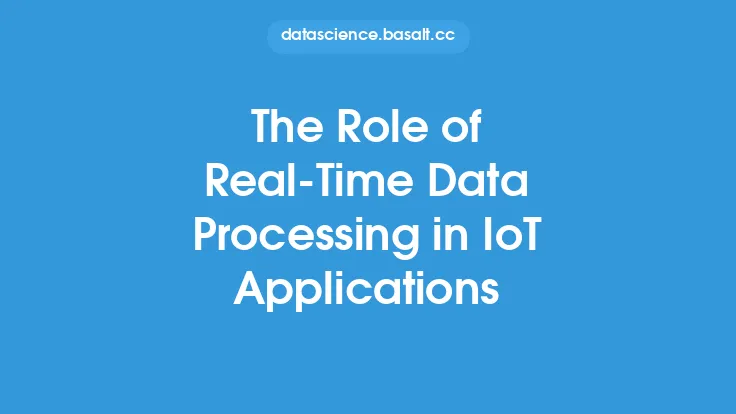Real-time data processing has become a crucial aspect of modern data engineering, enabling organizations to make informed decisions and respond to events as they occur. Apache Flink is a popular open-source platform for real-time data processing, providing a robust and scalable framework for handling high-volume and high-velocity data streams. In this tutorial, we will delve into the world of real-time data processing with Apache Flink, exploring its core concepts, architecture, and applications.
Introduction to Apache Flink
Apache Flink is a distributed processing engine that provides a unified platform for batch and stream processing. It was designed to handle the challenges of real-time data processing, such as high-throughput, low-latency, and fault-tolerance. Flink's architecture is based on a modular design, allowing developers to build custom applications using a variety of APIs, including Java, Scala, and Python. At its core, Flink provides a powerful processing engine that can handle a wide range of data sources, including files, sockets, and messaging systems.
Core Concepts of Apache Flink
To work with Apache Flink, it's essential to understand its core concepts, including:
- Streams: A stream is a sequence of data elements that are processed in real-time. Flink provides two types of streams: data streams and event-time streams. Data streams are processed based on the arrival time of the data, while event-time streams are processed based on the timestamp of the data.
- Operators: Operators are the building blocks of Flink applications. They are used to transform, aggregate, and process data streams. Flink provides a wide range of operators, including map, filter, reduce, and aggregate.
- State: State is used to store data that needs to be preserved across multiple processing operations. Flink provides a variety of state backends, including memory, file, and database-based state.
- Checkpoints: Checkpoints are used to save the state of a Flink application at regular intervals. This allows the application to recover from failures and maintain its state.
Architecture of Apache Flink
The architecture of Apache Flink is designed to provide a scalable and fault-tolerant platform for real-time data processing. The core components of Flink's architecture include:
- JobManager: The JobManager is the central component of Flink's architecture. It is responsible for managing the lifecycle of Flink applications, including deployment, execution, and monitoring.
- TaskManager: The TaskManager is responsible for executing Flink tasks, including data processing and state management.
- DataStream: The DataStream is the core data structure of Flink, representing a sequence of data elements that are processed in real-time.
- Operator Chain: The Operator Chain is a sequence of operators that are used to process data streams.
Real-Time Data Processing with Apache Flink
Apache Flink provides a wide range of features and tools for real-time data processing, including:
- Event-time processing: Flink provides support for event-time processing, allowing developers to process data based on the timestamp of the data.
- Watermarking: Watermarking is used to handle late-arriving data, ensuring that Flink applications can process data in a timely and efficient manner.
- Windowing: Windowing is used to divide data streams into fixed-size windows, allowing developers to process data in a batch-like manner.
- Aggregations: Flink provides a wide range of aggregation operators, including sum, count, and average.
Applications of Apache Flink
Apache Flink has a wide range of applications, including:
- Real-time analytics: Flink can be used to build real-time analytics applications, providing insights into customer behavior, market trends, and operational performance.
- IoT data processing: Flink can be used to process IoT data, including sensor data, log data, and other types of machine-generated data.
- Financial services: Flink can be used in financial services, including risk management, trading, and compliance.
- Gaming: Flink can be used in gaming, including real-time scoring, leaderboards, and player tracking.
Best Practices for Working with Apache Flink
To get the most out of Apache Flink, it's essential to follow best practices, including:
- Use event-time processing: Event-time processing provides a more accurate and efficient way of processing data, especially in applications where data arrives at different times.
- Use watermarking: Watermarking helps to handle late-arriving data, ensuring that Flink applications can process data in a timely and efficient manner.
- Optimize operator chains: Optimizing operator chains can help to improve the performance of Flink applications, reducing latency and increasing throughput.
- Use state backends: State backends provide a way to store data that needs to be preserved across multiple processing operations, ensuring that Flink applications can maintain their state.
Conclusion
Apache Flink is a powerful platform for real-time data processing, providing a robust and scalable framework for handling high-volume and high-velocity data streams. By understanding the core concepts, architecture, and applications of Flink, developers can build custom applications that provide real-time insights and support business decision-making. Whether you're working in finance, gaming, or IoT, Apache Flink provides a flexible and efficient way to process data in real-time, making it an essential tool for any data engineering team.





